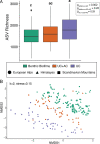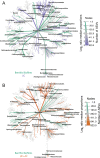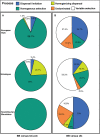Benthic Biofilms in Glacier-Fed Streams from Scandinavia to the Himalayas Host Distinct Bacterial Communities Compared with the Streamwater
- PMID: 35674429
- PMCID: PMC9238418
- DOI: 10.1128/aem.00421-22
Benthic Biofilms in Glacier-Fed Streams from Scandinavia to the Himalayas Host Distinct Bacterial Communities Compared with the Streamwater
Abstract
Microbial life in glacier-fed streams (GFSs) is dominated by benthic biofilms which fulfill critical ecosystem processes. However, it remains unclear how the bacterial communities of these biofilms assemble in stream ecosystems characterized by rapid turnover of benthic habitats and high suspended sediment loads. Using16S rRNA gene amplicon sequence data collected from 54 GFSs across the Himalayas, European Alps, and Scandinavian Mountains, we found that benthic biofilms harbor bacterial communities that are distinct from the bacterial assemblages suspended in the streamwater. Our data showed a decrease in species richness in the benthic biofilms compared to the bacterial cells putatively free-living in the water. The benthic biofilms also differed from the suspended water fractions in terms of community composition. Differential abundance analyses highlighted bacterial families that were specific to the benthic biofilms and the suspended assemblages. Notably, source-sink models suggested that the benthic biofilm communities are not simply a subset of the suspended assemblages. Rather, we found evidence that deterministic processes (e.g., species sorting) shape the benthic biofilm communities. This is unexpected given the high vertical mixing of water and contained bacterial cells in GFSs and further highlights the benthic biofilm mode of life as one that is determined through niche-related processes. Our findings therefore reveal a "native" benthic biofilm community in an ecosystem that is currently threatened by climate-induced glacier shrinkage. IMPORTANCE Benthic biofilms represent the dominant form of life in glacier-fed streams. However, it remains unclear how bacterial communities within these biofilms assemble. Our findings from glacier-fed streams from three major mountain ranges across the Himalayas, the European Alps and the Scandinavian Mountains reveal a bacterial community associated with benthic biofilms that is distinct from the assemblage in the overlying streamwater. Our analyses suggest that selection is the underlying process to this differentiation. This is unexpected given that bacterial cells that are freely living or attached to the abundant sediment particles suspended in the water continuously mix with the benthic biofilms. The latter colonize loose sediments that are subject to high turnover owing to the forces of the water flow. Our research unravels the existence of a microbiome specific to benthic biofilms in glacier-fed streams, now under major threats due to global warming.
Keywords: benthic biofilms; community assembly; community composition; glacier-fed streams.
Conflict of interest statement
The authors declare no conflict of interest.
Figures




Similar articles
-
Homogeneous Environmental Selection Structures the Bacterial Communities of Benthic Biofilms in Proglacial Floodplain Streams.Appl Environ Microbiol. 2023 Mar 29;89(3):e0201022. doi: 10.1128/aem.02010-22. Epub 2023 Feb 27. Appl Environ Microbiol. 2023. PMID: 36847567 Free PMC article.
-
Microbial biodiversity in glacier-fed streams.ISME J. 2013 Aug;7(8):1651-60. doi: 10.1038/ismej.2013.44. Epub 2013 Mar 14. ISME J. 2013. PMID: 23486246 Free PMC article.
-
Rare but active taxa contribute to community dynamics of benthic biofilms in glacier-fed streams.Environ Microbiol. 2014 Aug;16(8):2514-24. doi: 10.1111/1462-2920.12392. Epub 2014 Feb 18. Environ Microbiol. 2014. PMID: 24428193
-
Microbial ecology of mountain glacier ecosystems: biodiversity, ecological connections and implications of a warming climate.Environ Microbiol. 2017 Aug;19(8):2935-2948. doi: 10.1111/1462-2920.13766. Epub 2017 May 30. Environ Microbiol. 2017. PMID: 28419666 Review.
-
The ecology and biogeochemistry of stream biofilms.Nat Rev Microbiol. 2016 Apr;14(4):251-63. doi: 10.1038/nrmicro.2016.15. Nat Rev Microbiol. 2016. PMID: 26972916 Review.
Cited by
-
Predicting climate-change impacts on the global glacier-fed stream microbiome.Nat Commun. 2025 Feb 1;16(1):1264. doi: 10.1038/s41467-025-56426-4. Nat Commun. 2025. PMID: 39893166 Free PMC article.
-
Diversity and biogeography of the bacterial microbiome in glacier-fed streams.Nature. 2025 Jan;637(8046):622-630. doi: 10.1038/s41586-024-08313-z. Epub 2025 Jan 1. Nature. 2025. PMID: 39743584 Free PMC article.
-
Environmental micro-niche filtering shapes bacterial pioneer communities during primary colonization of a Himalayas' glacier forefield.Environ Microbiol. 2022 Dec;24(12):5998-6016. doi: 10.1111/1462-2920.16268. Epub 2022 Nov 18. Environ Microbiol. 2022. PMID: 36325730 Free PMC article.
-
Mapping the metagenomic diversity of the multi-kingdom glacier-fed stream microbiome.Nat Microbiol. 2025 Jan;10(1):217-230. doi: 10.1038/s41564-024-01874-9. Epub 2025 Jan 2. Nat Microbiol. 2025. PMID: 39747693
-
Experimental evidence on the impact of climate-induced hydrological and thermal variations on glacier-fed stream biofilms.FEMS Microbiol Ecol. 2025 Jan 7;101(1):fiae163. doi: 10.1093/femsec/fiae163. FEMS Microbiol Ecol. 2025. PMID: 39674808 Free PMC article.
References
-
- Rinaldo A, Gatto M, Rodríguez-Iturbe I. 2020. River networks as ecological corridors: species, populations, pathogens. Cambridge University Press.
Publication types
MeSH terms
Substances
LinkOut - more resources
Full Text Sources

